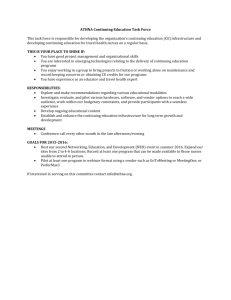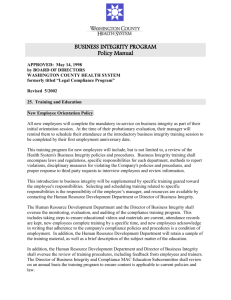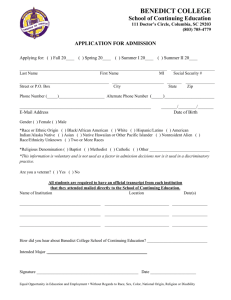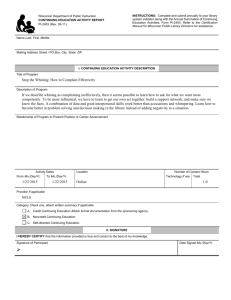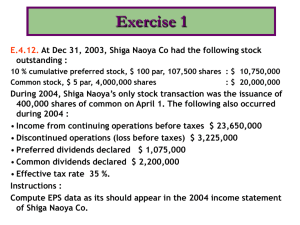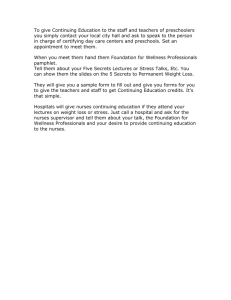E2-1. Determining accrual and cash basis revenue (AICPA adapted)
advertisement
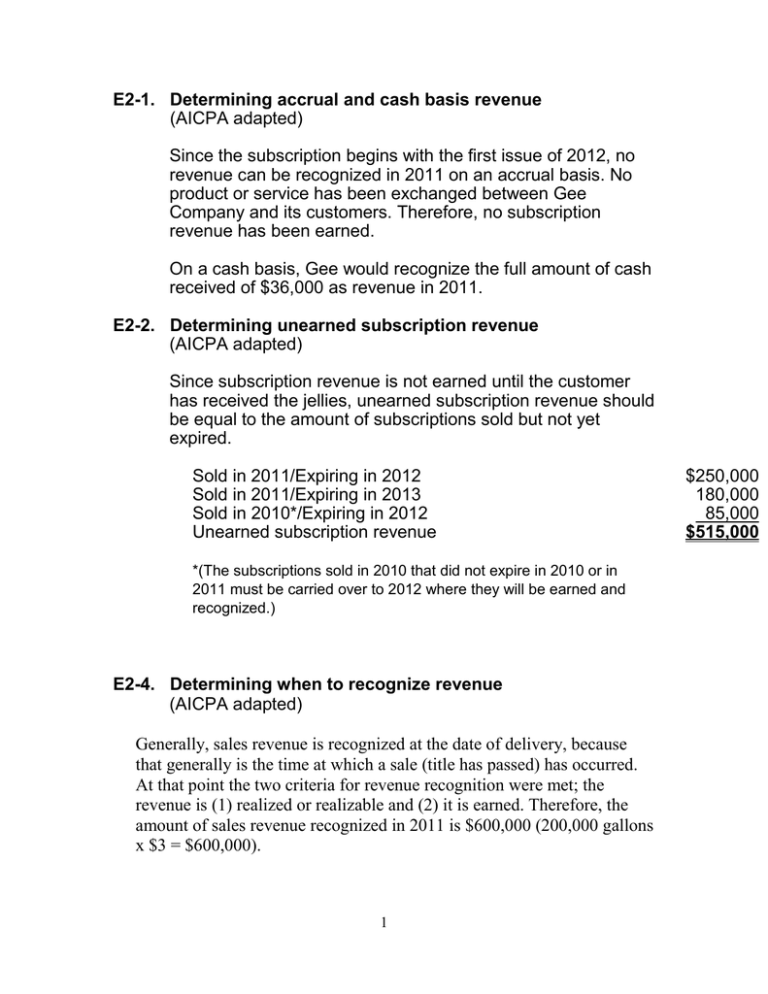
E2-1. Determining accrual and cash basis revenue (AICPA adapted) Since the subscription begins with the first issue of 2012, no revenue can be recognized in 2011 on an accrual basis. No product or service has been exchanged between Gee Company and its customers. Therefore, no subscription revenue has been earned. On a cash basis, Gee would recognize the full amount of cash received of $36,000 as revenue in 2011. E2-2. Determining unearned subscription revenue (AICPA adapted) Since subscription revenue is not earned until the customer has received the jellies, unearned subscription revenue should be equal to the amount of subscriptions sold but not yet expired. Sold in 2011/Expiring in 2012 Sold in 2011/Expiring in 2013 Sold in 2010*/Expiring in 2012 Unearned subscription revenue *(The subscriptions sold in 2010 that did not expire in 2010 or in 2011 must be carried over to 2012 where they will be earned and recognized.) E2-4. Determining when to recognize revenue (AICPA adapted) Generally, sales revenue is recognized at the date of delivery, because that generally is the time at which a sale (title has passed) has occurred. At that point the two criteria for revenue recognition were met; the revenue is (1) realized or realizable and (2) it is earned. Therefore, the amount of sales revenue recognized in 2011 is $600,000 (200,000 gallons x $3 = $600,000). 1 $250,000 180,000 85,000 $515,000 E2-16. Income statement presentation Event 1 is a discontinued operation and would appear on the income statement below income from continuing operations. To qualify for discontinued operation treatment, the sold component must be separable, both operationally and financially, from the rest of the operation. Further, Krewatch cannot have any significant continuing involvement in the operations of the sold component. These conditions appear to be met. Although Krewatch is still carrying the accessory line, the company is buying these products from the plant’s new owners and is not involved in the plant’s operations. Event 2 would be reported as a special, nonrecurring or unusual item and thus would be included in income from continuing operations. Restructurings may be infrequent, but they are not that unusual in today’s business environment so this event is not an extraordinary item. Event 3 is an extraordinary item and would appear on the income statement below income from continuing operations. Pre-codification FAS 145 eliminated the requirement that all gains/losses from early extinguishment of debt be treated as extraordinary items. Consequently, to qualify for extraordinary treatment, an extinguishment now must meet the unusual and infrequent test. Given that the retired bonds were the only ones issued in the company’s history, this test appears to be met. Event 4 is a change in accounting principle and would require retrospective application (i.e., prior year income statement numbers presented for comparative purposes would be restated to reflect the average cost method of inventory costing. The current year income statement numbers would be based on applying the average cost method. The effect of the accounting principle change on the current period income numbers would be disclosed in a note to the financial statements explaining the accounting change. 2 Event 5 is a change in accounting estimate and thus would be included in income from continuing operations. No special income statement disclosure of this event is required. Depreciation expense in 2011 (and beyond) will be calculated using the (new) shorter lives. The range of equipment lives used for depreciation purposes may need to be adjusted in the notes to Krewatch’s financial statements. Event 6 is a special, nonrecurring or unusual item and thus would be included in income from continuing operations. Inventory write-offs may be infrequent, but they are not unusual so this event is not an extraordinary item. Event 7 is a special, nonrecurring or unusual item and thus would be included in income from continuing operations. Equipment sales are considered a normal part of ongoing business activity. E2-17. Comprehensive income JDW Corporation Income Statement and Statement of Comprehensive Income For the Year Ended December 31, 2011 Sales $ 2,929,500 Cost of goods sold (1,786,995) Gross profit 1,142,505 Selling and administrative expenses (585,900) Income from operations, before income taxes 556,605 Income taxes (166,982) Net income $ 389,623 Net income Unrealized holding loss, net of tax of $6,600 Foreign currency translation adjustment, net of tax of $11,250 taxtax Unrealized loss from pension adjustment, net of tax of $2,100 Comprehensive income 3 $ 389,623 (15,400) 26,250 $ (4,900) 395,573 P2-11 Income statement preparation with irregular items Jordan Wing, Inc. Partial Income Statement For the Year Ended December 31, 2011 Income from continuing operations * $ 5,184,900 * before income taxes Income tax expense Income from continuing operations Discontinued operations: Loss from discontinued operations, net of (1,814,715) $ 3,370,185 tax benefit of $120,750 Income before extraordinary item (224,250) $ 3,145,935 Extraordinary loss, net of tax benefit of $29,225 Net income (54,275) $ 3,091,660 Earnings per common share: Income from continuing operations Discontinued operations: Loss from discontinued operations, not of net of tax Income before extraordinary item Extraordinary loss, net of income tax effect Net income **Net income Pretax income = (Net income / (1 - tax rate) Add: Loss on discontinued operations Add: Extraordinary loss Income from continuing operations before taxes 4 $ 22.47 (1.50) 20.97 (0.36) $ 20.61 $ $ 3,091,660 4,756,400 345,000 83,500 5,184,900 Note to the instructor: Several items are described in the problem data that should not be separately disclosed among the irregular items that follow income from continuing operations. These include: The trademark infringement gain, while infrequent, is not unusual so the gain should be included in income from continuing operations and separately disclosed. The gain from selling Xerox stock should be among the items comprising income from continuing operations and separately disclosed. The unrecorded impairment loss (although discovered in 2011) constitutes an error in a prior year’s financial statements, and thus, is reported as a prior period adjustment by restating the 2010 financial statements if presented. If 2010 financial statements are not presented, the opening balance of retained earnings should be adjusted. In accordance with GAAP, the change in depreciation method is treated as a change in accounting estimate effected by a change in accounting principle. Thus, income from continuing operations (correctly in 2011) reflects the new method; no restatement or retrospective adjustment of amounts reported in prior years is permitted. 5 P2-12. Components held for sale Silvertip Construction, Inc. Partial Income Statement For the Year Ended December 31, 2011 Income from continuing operations $ 1,650,000 Discontinued operations: Loss from operation of held for sale business component, net of tax benefit of $33,250 *(61,750) Impairment loss on held for sale component, net of tax benefit of $24,185 **(44,915) Net income $ 1,543,335 Earnings per share: Income from continuing operations Discontinued operations: Loss from operation of held for sale business component, net of tax Impairment loss on held for sale component, net of tax Net income Fair value of component -Expected cost to sell component (FV x .06) Fair value of component minus cost to sell -Book value of component Impairment loss on held for sale component $ 1.65 (0.06) $ (0.04) 1.54 $ 735,000 (44,100) 690,900 (760,000) $ (69,100) * Operating loss on component = pretax loss x (1 – tax rate) = $95,000 x (1 – .35) = $61,750 ** Impairment loss on component = pretax loss x (1 – tax rate) = $69,100 x (1 – .35) = $44,915 6

